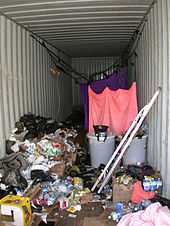Stowaway


A stowaway is a person who secretly boards a vehicle, such as an aircraft, bus, ship, cargo truck or train, to travel without paying and without being detected.
Air travel
Poor perimeter security at a number of airports around the world can make it easier for people to stow away on planes.[1]
Stowaways in aircraft wheel wells face numerous health risks, many of which are fatal: being mangled when undercarriage retracts, tinnitus, deafness, hypothermia, hypoxia, frostbite, acidosis and finally falling when the doors of the compartment reopen.[2] The landing gear compartment is not equipped with heating, pressure or oxygen, which are vital for survival at a high altitude.[2] According to experts, at 18,000 feet (5,500 m), hypoxia causes lightheadedness, weakness, vision impairment and tremors. By 22,000 feet (6,700 m) the oxygen level of the blood drops and the person will struggle to stay conscious.[2] Above 33,000 feet (10,000 m) their lungs would need artificial pressure to operate normally.[2] The temperature could drop as low as −63 °C (−81 °F) which causes severe hypothermia.[2] Those stowaways who managed to not be crushed by the retracting undercarriage or killed by the deadly conditions would most likely be unconscious when the compartment door re-opens during the approach and fall several thousand feet to their deaths.[2]
David Learmount, an aviation expert of Flight International, told BBC about a lot of ignorance in this area. He suggested that no one would be willing to risk such journey, having full understanding of this kind of ordeal.[2] Stowaways who survived usually traveled relatively short distances or at a low altitude.[2] One case is known of a person who survived an altitude of about 39,000 feet (12,000 m); Almost all aircraft stowaways are male.[2]
In one reported case, in 2003, a young man mailed himself in a large box and had it shipped on UPS planes from New York City to Texas. He survived because the box travelled in a pressurized hold of an aircraft.[3]
From 1947 until September 2012, there were 96 known stowaway attempts worldwide in wheel wells of 85 separate flights, which resulted in 73 deaths with only 23 survivors.[2]
Security
Stowaways may risk being imprisoned, since it is illegal in most jurisdictions to embark on aircraft, boats or trains as stowaways. Airports, sea ports and train stations are typically marked as "no trespassing" or "private property" zones to anyone but customers and employees. Seaports, train stations, and airports often attempt further security by designating restricted areas with signs saying "authorized personnel Only".
Since the September 11 attacks, it has become more difficult to be a stowaway on board transportation arriving to or departing from the United States. Airport security has dramatically increased, and among the new security measures is watching over the fences from which stowaways usually gain entrance to an airport's runway.
Rail transportation
Sea travel
The Convention on Facilitation of International Maritime Traffic, 1965, as amended, (The FAL Convention), define stowaway as "A person who is secreted on a ship, or in cargo which is subsequently loaded on the ship, without the consent of the shipowner or the master or any other responsible person and who is detected on board the ship after it has departed from a port, or in the cargo while unloading it in the port of arrival, and is reported as a stowaway by the master to the appropriate authorities".
Unnoticed by the captain, crew, port officials and customs authorities, stowaways may gain access to a ship with or without the assistance of port personnel. Once on board the ship, stowaways hide in empty containers, cargo holds, tanks, tunnels, behind false panels, stores, accommodation areas, engine rooms, void spaces, cranes and chain lockers.
The presence of stowaways on board ships may bring serious consequences for ships and, by extension, to the shipping industry as a whole; the ship could be delayed in port; the repatriation of stowaways can be a very complex and costly procedure involving masters, shipowners, port authorities and agents, and the life of stowaways could be endangered as they may spent several days hidden, with the risk of suffocation and without any food or water.[4]
See also
References
- ↑ "'He's a lost soul': mystery of man who fell to earth from plane". AP. The Sydney Morning Herald. 11 December 2012. Retrieved 30 December 2012.
- ↑ 2.0 2.1 2.2 2.3 2.4 2.5 2.6 2.7 2.8 2.9 Kelly, Jon (September 13, 2012). "How often do plane stowaways fall from the sky?". BBC News. Retrieved September 13, 2012.
- ↑ Hannaford, Alex (2004-08-29), "The crate escape", The Guardian
- ↑ http://www.imo.org/ourwork/facilitation/stowaways/Pages/Default.aspx
External links
- Survival at high altitudes: wheel-well passengers
- Aviat Space Environ Med. 1996 Aug;67(8):784-6
- The 1996 study was updated and published by The Flight Safety Foundation in 1997